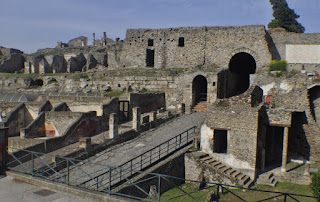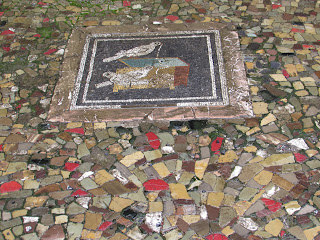 |
| View from our stateroom balcony |
The skies were still gloomy and there was the occasional sprinkle of rain as Adolfo drove us to Pompeii, our first stop for the day. Along the way, Adolfo tells us a little about the history of Pompeii and Mount Vesuvius, which we can see in the distance.
Pompeii, founded in 600 B.C., eventually became a booming trading city. Then, on August 24, 79 A.D., everything changed. Vesuvius erupted and buried the city under 30 feet of volcanic ash. When it was excavated centuries later, we now have the best look anywhere of what life in Roman times must have been like 2,000 years ago. Most streets would have been lined with stalls and jammed with shoppers. At this time, Rome controlled the entire Mediterranean and Pompeii was a central and busy port. There were no posh neighborhoods in Pompeii. Rich and poor lived side by side in elegant houses and simple homes.
Here's an artist's painting of what Pompeii probably looked like before the eruption.
Today Pompeii looks like this after excavation.
 |
| Aerial view from the internet |
Once we arrived at Pompeii, Adolfo introduced us to our guide, Charlotta, who took our small group through Pompeii. She was wonderful. We spent 2 hours walking through the ruins of Pompeii with Charlotta giving a wonderful dialog about what life was like back in 79 A.D.
 |
| Our Pompeii guide, Charlotta |
We started our tour at the Porta Marina, the original main town gate. Before Vesuvius erupted and filled in the harbor, the sea came up to the town.
Every day the people of Pompeii flooded the streets with water to clean them. The stepping-stones let pedestrians cross without getting their feet wet. Chariots could straddle the stones as they passed.
 |
| The 3 stepping stones meant this was a major thoroughfare. |
Mount Vesuvius is seen in the distance...about 5 miles away. When it blew, Pompeiians had no idea they were living under a volcano, since Vesuvius had not erupted for 1,200 years. During the eruption, the weight of the ash and small rocks collapsed Pompeii's roofs, crushing people who had taken refuge inside buildings instead of fleeing the city.
Pompeii's basilica was a first-century palace of justice. This ancient law court has the same floor plan later adopted by many Christian churches (basilicas).
We asked Charlotta to take our group photo "inside" the basilica.
We walk down the street to the Casa del Fauno, or House of the Faun. It is the largest home in Pompeii with 40 rooms and 27,000 square feet.
Inside the house there is a statue in the courtyard of the "Dancing Faun"
The house had colorful mosaics.
We next visit the bakery and mill. When excavated, the brick oven contained loaves of bread.
The stone tower to the right of the oven is a flour grinder. Grain was poured into the top and donkeys or slaves pushed wooden bars that turned the stone. The powdered grain dropped out of the bottom as flour. Each neighborhood had a bakery like this.
Archaeologists are still at work on items that have been excavated.
There were plaster castings of Pompeiians captured in their last moments. They had been quickly suffocated by a superheated avalanche of gas and ash and their bodies encased in volcanic debris. While excavating, archaeologists detected hollow spaces underfoot, created when the victims' bodies decomposed. By gently filling the holes with plaster, they were able to create molds of the Pompeiians who were caught in the disaster.
Pompeii had 6 public baths, each with a men's and women's section. Below is a photo of the men's section.
Romans soaked in a big tub, which was filled with hot water.Also in the room was a fountain which spouted water onto the hot floor, creating steam.
Here is one of the many fast-food joints. Most ancient Romans did not cook for themselves so places like this were common. The holes in the counters held the pots for food.
There was so much to see in Pompeii and our 2-hour tour went fast. We bid farewell to Charlotta and then Adolfo drove us up the mountainside of Mount Vesuvius, which is a National Park. Adolfo said that the police collect 6 Euro for each car and 50 Euro for each bus to drive up the mountain, which the police seem to pocket for themselves. Hmmmm....We also had to pay 10 Euro per person for entry to walk the last 300 meters up to the crater on Mount Vesuvius. It was a steep walk on loose volcanic rock but very rewarding to see the crater.
Then it was back down the trail and Adolfo brought us to a very nice restaurant for lunch where we all had Capriccio pizzas and local red wine.
With the help of a Rick Steves book pointing out what the buildings were, the 7 of us wandered through the ruins.
 |
| Overview of the ruins |
Another example of a fast-food joint with giant jars for wine, oil, and snacks.
The rooms of the buildings had colorful frescoes decorating the walls.
A room that is yet to be completely excavated.
The boat house are the arches at the bottom of the photo. The beach was here and during excavations in 1981, hundreds of skeletons were discovered inside the boat houses. Some of Herculaneum's 4,000 citizens tried to escape by sea, but were overtaken by pyroclastic flows.
We only spent about an hour wandering around the ruins. The skies were threatening with lightening and thunder so we quickly headed back to meet Adolfo and our van just in time before the rain started.
 |
| Adolfo |
It was then back to the port after a most wonderful day. Adolfo Scotto di Luzio was a wonderful, friendly, and knowledgeable driver and I would highly recommend his services.
We had hoped to have time to visit the Archaeological Museum in Naples but it was not possible to squeeze that in our busy day. That museum houses the best art and artifacts that were excavated from both Pompeii and Herculaneum. If we visit Naples again, we will be sure to go there!
Next port.....Mykonos, Greece




































No comments:
Post a Comment